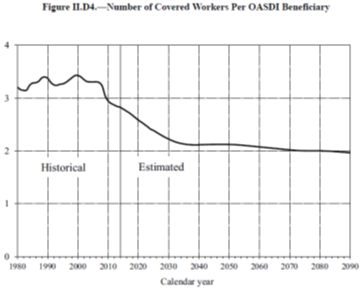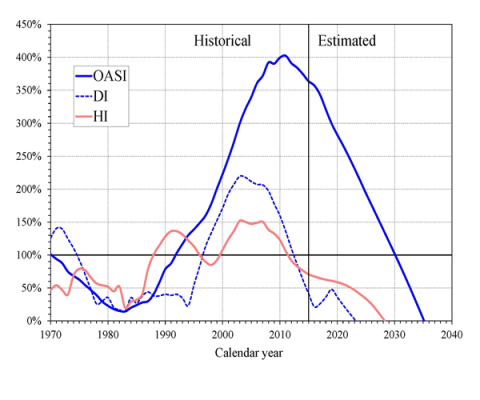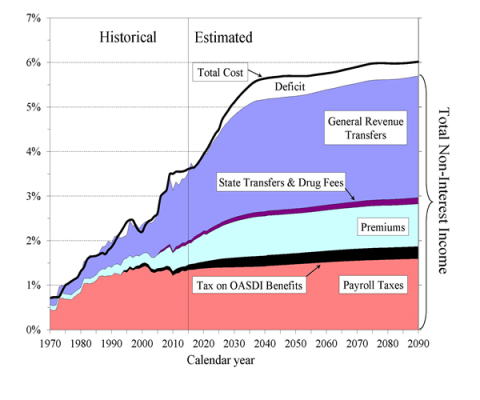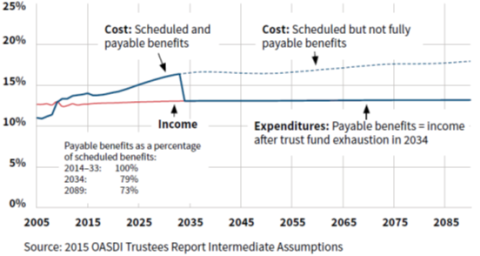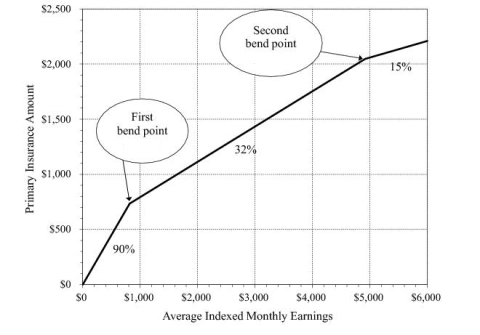
Social Security and Medicare Financial Overview
Social Security and Medicare are very important programs. Those currently receiving Social Security benefits appreciate the monthly income that grows with inflation and continues as long as they live. The Medicare program provides health coverage during potentially vulnerable times. But some people who haven’t started receiving benefits wonder if the programs will be around when they retire. The answer is yes but benefits may be reduced and/or additional taxes required. This post will provide a brief financial overview of these programs in a Q&A format. This is an important issue not getting the attention that is required.
Before I begin, there are two important documents I encourage you to become familiar with:
- Social Security Statement – available online at https://www.ssa.gov/myaccount/ - provides an estimate of your different monthly benefits. If you don’t sign up online, paper statements will be mailed every five years (age 25, 30, 35, etc.). Annual mailings stopped in 2011 to save about $70mm per year.
- Annual Trustee Report – available online at https://www.ssa.gov/OACT/TRSUM/index.html - shows the financial health of both programs and future actuarial projections. The latest report was released June 22, 2016.
What is Social Security?
Social Security is a social insurance program that provides benefits for individuals or family members who satisfy the number of years worked (and paid taxes) to qualify. Many people are familiar with the retirement income for retirees but the program also covers disabled individuals and survivor benefits for families with children. The complete name is the Old-Age, Survivors, And Disability Insurance programs or OASDI. The benefits received under these different scenarios are found on the Social Security Statement. Because of these various insurance components – longevity, disability and early death – an implied rate of return on retirement benefits only is not an appropriate analysis of the program.
You haven’t mentioned Medicare – isn’t that part of Social Security?
Medicare is separate and consists of two programs - Hospital Insurance (also known as Part A) and Supplemental Medical Insurance (Part B and Part D). Part A covers hospital, home health after hospital stays and hospice; Part B covers doctor bills, outpatient services and home health; Part D covers prescription drugs. The Social Security office will help individuals sign up for Medicare but it is a separate program.
Who pays for Social Security and Medicare?
Current workers pay 6.2% of their income for Social Security and 1.45% for Medicare Part A for a total of 7.65%. This is sometimes called “payroll tax” or “FICA tax”. You don’t see on your paycheck but your employer also pays the same 7.65% based on your income. The self-employed pay the full 15.3%. The 6.2% Social Security is paid on income up to $118,500 (for 2016) but the 1.45% Medicare tax is paid on full income. There is an additional 0.9% Medicare tax for income above $200,000 for individuals and $250,000 for joint filers that started in 2013 to help fund part of Obamacare. This is only paid by the employee.
Medicare Part B and Part D is funded from two sources – about 75% comes from general revenue of our generous taxpayers and 25% comes from monthly premiums by retirees. Additional tiered premiums for Part B are required for high income retirees (above $85,000 for individual filers; $170,000 for joint filers). See my previous post for further details.
Does each worker have their own account where the payroll taxes go until they retire?
No. Unlike your 401k account or savings account that is only for you, Social Security and Medicare Part A uses something called “pay-as-you-go funding”. This means the payroll taxes being collected by current workers is used to pay the bills for existing retirees. When the existing workers are retired, the next generation of workers will be paying their bills. Yes, the number of workers relative to the number of retirees can change over time and impacts the financing. As recent as 2000 there were 3.4 active workers for each 1 Social Security beneficiary; it is projected to be 2.1 in 2034 (see graph below; Source: 2016 Annual Social Security Trustee Report). The Social Security and Medicare actuaries are able to project the expected financial impact on these changing demographics. The tough part is convincing politicians and the public to make the tough choices now.
What happens to the extra payroll tax not needed to pay current benefits?
This is where the Trust Funds come in. Back when the payroll tax coming in was more than benefits going out, the excess was earmarked into Trust Funds. Then later when the payroll tax fell short of benefits going out (which has occurred since 2010) the difference was made up by the Trust Funds. Technically the Trust Funds are simply IOU’s from the government but that is a separate, complex topic (anyone remember Al Gore’s “lockbox” proposal… or at least the SNL skit?). It is these Trust Funds and the year they are projected to go to $0 that summarizes the health of the programs.
So how soon will the Trust Funds hit $0? Then what happens?
Social Security has a separate Trust Fund for Old-Age and Survivors and another Trust Fund for Disability. The Disability Trust Fund would have hit $0 in 2016 – yes now – but the Bipartisan Budget Act of 2015 diverted some funds from Old-Age and Survivors Fund to keep it going until 2023. The Old-Age and Survivor Trust Fund is projected to hit $0 in 2035 at which time only current payroll tax could be used to pay benefits (about 79% of promised at that time). The combined OASDI Trust Funds would hit $0 in 2034. Currently the interest income from the Trust Funds is sufficient to cover the shortfall. It is projected that principal will need to be tapped in 2019. That is when the IOU’s from the government will get very interesting.
Medicare Hospital Insurance Trust Fund (Part A) is projected to run out in 2028. Current payroll tax is projected to cover about 87% of promised benefits at that time, drifting down to 79% by 2043.
Medicare Supplementary Medical Insurance Trust Fund (Part B and D) is projected to “remain adequately financed into the indefinite future because current law provides financing from general revenues and beneficiary premiums each year to meet the next year's expected costs.” However, the cost to us taxpayers and Medicare premium payers are expected to rise from about 2.1% of GDP in 2015 to 3.5% in 2037 – a big number.
Here is a picture of the Social Security (OASI, DI) and Medicare (HI) Trust Fund Ratios (Assets as % of Annual Cost) – Source: A Summary of the 2016 Annual Reports:
Wait a minute. Tell me about Medicare funding again?
Only the Hospital Insurance (Part A) is funded by payroll taxes (see orange area in graph below – Source: A Summary of the 2016 Annual Reports). The Supplementary Medical Insurance (Part B and D) has about 25% funding from Medicare premiums and most of the other 75% from general taxing revenue including the taxes on the Social Security benefits! That is why the Medicare premiums seem so reasonable. What is staggering is the projected cost as a % of GDP for the program – the majority coming from general tax revenue based on current law – not payroll taxes or dedicated premiums.
So should I assume I will get nothing from Social Security?
No. You will very likely get less than currently promised but it won’t be $0. Remember Social Security is a pay-as-you-go system. If the Trust Funds are depleted you will still have current payroll tax coming in to pay benefits. The graphic below (Source: The Actuary Magazine – Apr/May 2016) shows that while there won’t be enough funds to pay the current promises, it will be enough to pay 79% in the first year funds run out, then drifting down to 73% for long-range projections. In reality, it will likely be some combination of lower benefits and higher taxes to avoid this cliff. I currently use 85% of projected Social Security benefits for clients under age 55 to reflect this likely combination. It is unlikely politicians will pass major changes to benefits for those in or near retirement.
Can’t they just raise taxes on everybody to cover the shortfall?
Sure - an extra 2.7% of your income is projected to cover the Social Security shortfall (but not Medicare). But recall the total payroll tax (both employee and employer) is already 15.3% when you include Medicare Part A. This rate was 9.35% in 1983 and 5.40% in 1965. It is important to recall the original intent of Social Security was to keep individuals out of poverty, not to provide full retirement income for most Americans. It is difficult to make changes when the impact is so far down the road, but as we saw with the Disability Trust Fund the day of reckoning is upon us. The continuous increase of benefits and related taxes is not the answer. Rather, determine what % of your total income should be forced into a government program that provides a necessary safety net to keep people out of poverty and leave the remaining amount in the hands of the individual to keep and save as they see fit.
Can’t they just raise taxes on the high income earners?
It is important to realize both Social Security and Medicare are already doing this in a few ways.
- Social Security uses “bend points” on the benefit received.Everyone pays the same 6.2% on income but the amount of benefit paid is based on 90% of first $856 in monthly earnings, then 32% on income between $856 - $5,157, and finally 15% above. So the lower income workers are receiving a much higher % of their income as a benefit.Keeping with the “social” part of the program and lifting individuals out of poverty this make sense.But it should be recognized the benefit calculation is already quite progressive (see graph below).
- Social Security now requires taxpayers with ‘base income’ in excess of thresholds to include up to 85% of their benefits as taxable income (threshold is $25,000 for single filer; $32,000 for joint filers). There are a few tiers from 0% to 50% to 85% but the program is now picking up revenue from taxes on benefits. Note these thresholds ARE NOT adjusted for inflation and have been the same since the passage of the 1983 Amendments to the Social Security Act which made Social Security benefits subject to tax. It is interesting to note $35,700 was the maximum wage limit for Social Security taxes in 1983. That wage limit is adjusted for inflation and today is $118,500. I bet there are many middle income beneficiaries that weren’t concerned about the new tax in 1983 given the high threshold level that now find themselves giving back part of their promised benefits through this tax. Another note – the extra 0.90% Medicare tax on income above $200k single and $250k joint is also not indexed to inflation.
- Medicare collects a higher monthly premium on high income beneficiaries. See my previous blog post.
What changes to Social Security are being considered and what is the impact on funding?
There are different changes being considered to the Social Security program. A summary of the changes and the financial impact to the program is summarized by the Office of the Chief Actuary and can be found at here https://www.ssa.gov/OACT/solvency/provisions/index.html
Potential changes range from the type of cost-of-living adjustments to “bend point” changes to extending the retirement age to reflect longer life expectancy. It is likely some combination of these changes will ultimately be needed as the changes are negotiated. Note these are only changes to Social Security, not Medicare.
If you are still with me I hope this was helpful (send me an email!). It is important to be aware of the issue to not only help plan your retirement but also to engage in a thoughtful, well-informed debate about the best path forward for these important yet financially troubled programs.


